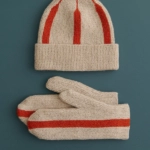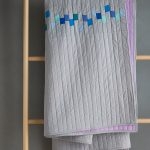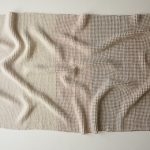Sewing a Button onto Knitwear
Have you ever gotten to the end of a cardigan pattern only to realize that you aren’t quite sure how to sew on the buttons? Sure, you can sew on onto a shirt… But a sweater?
While there are many ways to sew a button onto knitwear, here are two of our favorite methods: one without a backing button and one with. While both methods are very good at securing buttons, a button with a backing button is sturdier and gentler on the fabric. Give both a try and see which one you prefer!
To sew a button onto knitwear, you’ll need…
- A button that fits snuggly through the buttonhole
- A tapestry needle that fits through the holes of the button
- Some thread or fine yarn that fits through the eye of the needle
- A larger tapestry needle for creating the shank
- Scissors
- A fabric marker
- Optional: A smaller button, if you want to sew on a backing button
NOTE: These instructions are for a two-hole button but can be easily applied to a four-hole one!
Sewing On A Button Without A Backing
- Thread the needle and pull the thread, so that one end of the thread is slightly longer than the other. Insert the needle through one of the holes in the button from back to front, then from front to back, and pull the thread until the shorter end pulls clear of the button.
- With the two ends of the thread, make a square knot right near the ends of the threads. Make another knot, then snip the tails near the knot and slide the thread so that the knot is very close to the backside of the button.
- Find the stitch where you’d like to sew the button and mark it with a fabric marker. Place the button on that stitch, making sure the knot stays close to the backside of the button. Insert the needle to one side of the marked stitch from the right side of the fabric to the wrong side and then on the other side of the marked stitch, from wrong side to right side, coming up through the other hole of the button.
- Pull up gently on the button to loosen the thread a little and then slide the extra tapestry needle under the loop of thread at the top of the button. Now tighten the thread.
- Sew back and forth through both holes of the button, from right side to wrong side and wrong side to right side, three or four times. When finished, come up from the wrong side to the right side and then back down through the next hole of the button, but not through the fabric.
- Remove the extra tapestry needle and wrap the thread approximately four times around the bundle of threads under the button (i.e. the shank). Make a loop with the thread, pull the needle through it, and place the loop over the button and pull, creating a knot around the shank . Tighten the knot and repeat it for extra stability.
- Finally, insert the needle into the threads of the shank, pull the needle through the loop of thread to make a simple knot and tighten. Repeat this knot.
- Bring the needle through the fabric to the wrong side, right at the base of the shank. Trim the thread close to the fabric and you’re done!
Sewing On A Button With A Backing Button
- Work as for step 1, above.
- Work as for step 2, above.
- Find the stitch where you’d like to sew the button and mark it with a fabric marker. Place the button on that stitch, making sure the knot stays close to the backside of the button. Insert the needle to one side of the marked stitch from the right side of the fabric to the wrong side, and then through one of the holes of the backing button. Insert the needle through the other hole of the backing button, then through the fabric, from wrong side to right side, coming out on the other side of the marked stitch, and finally, through the second hole of the main button.
- Pull up gently on the main button to loosen the thread a little and slide the extra tapestry needle under the loop of thread at the top of this button. Now tighten the thread.
- Sew through all four holes of the two buttons, from right side to wrong side and wrong side to right side, three or four times. When finished, come up through the main button from wrong side to right side and then insert the needle back down the next hole but not through the fabric.
- – 8. Work as for steps 6-8, above.









Excellent demo on sewing on buttons to a knit. I love the idea of a backing button.
I just finished a knitting project except for adding the button. This piece could not be more timely. Thank you.
Thank you for this tutorial. I appreciate how slowly you went through the process. Your method seems much better than what I have done before. I especially like how you create the knot. Given how little I know about sewing and how much I detest it, my previous button attachments were rushed and probably not done well. The button I am attaching now will be well placed!
This demonstration is excellent and my sewing repertoire has advanced greatly…. thank you!
Thanks so much for the tutorials. Extremely helpful as I tackled a bigger project than usual!. Buttonholes, button sewing on, picking up stitches, seaming, better methods of weaving in ends all appreciated!
Hi,
If I have a four hole button, do I repeat the step with the other two holes before creating a shank?
Thanks, this was a great video tutorial!
Hi Natalie,
Thanks for your question! You are correct! For a four-hole button, you will want to repeat the steps for the other two holes before proceeding to the next step!
Feel free to let us know if you have any other questions and we would be happy to help!
Happy making,
Gavriella